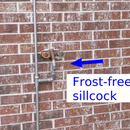outdoor shower that could truly never freeze
I want to plan in an exterior shower that is serviceable and will not freeze, looks inconspicuous enough, functions in the winter, and for efficiency hopefully doesn’t have hot water running up a standpipe exposed to the outside, and minimizes metal penetrations through the envelope.
The shower would be on an exterior wall shared with a bathroom.
All the designs I see are based on a standard frost-free faucet (mixing valve variety), exterior pipe up to shower head, and a gravity drain to free air when pressure is released.
In my head, a design like this makes a lot of sense:
– shower head is on a plastic, downward-sloped pipe that penetrates in to conditioned space (dramatically less thermal coupling than a copper frost-free faucet)
– single-lever mixing valve is in conditioned area; accessible via access-panel in bathroom (more maintainable than a standard frost-free, and much less thermal coupling with just a shaft for the lever to the outside)
– once shut-off, standpipe could still drain outside, but via a plastic pipe penetration (this would be easy, and prevent their from being a 1/2″ air hole into the structure when shower is off) – or perhaps there would be a clever way to get this to drain inside such as dumping into the (indoor) shower nearby.
Is something like this doable to code / are there any integrated products doing this?
As an example, the DIY and off-the-shelf versions of what I see are in the pictures, and linked here: https://www.youtube.com/watch?v=7YrhItQjcVA, https://www.homedepot.com/p/Prier-Products-1-2-in-Stainless-Steel-Freezeproof-Outdoor-Shower-with-C-108D12-12-in-Anti-Siphon-Hot-Cold-Wall-Hydrant-with-Inlet-C108SH1-C108D12/316678647 – how can we move all but the shower head and knob themselves inside the envelope?
GBA Detail Library
A collection of one thousand construction details organized by climate and house part











Replies
So long as the wall is thick enough to get the mixing valve inside, at least some of, the insulation I don't see why it wouldn't work. Might have to make an extension for the handle if they're not commercially available.
For the showerhead you could run a PEX vertical to a drop ear elbow, inside the insulation, then a SCH 80 CPVC nipple thru' the wall. Angle the drop ear elbow slightly so the nipple drains. I doubt it would freeze and if it did the PEX is unlikely to bust so I don't see any reason to drain it.
No guarantees with code interpretation. Inspector might mistake the CPVC for PVC conduit so keep the invoice handy.
Have you looked at the digital shower valves? Seems like they could do what you want. The controls are designed to live in as shower but might survive outdoors.
https://www.build.com/product/summary/1861091?uid=4399544&jmtest=gg-gbav2_4399544&srsltid=AR57-fAXH-qZAZmHpXpdo0Js_csTZLuzj_jsHGGlrEjqeyDV1Fp4q0Bz15I
Walta
Oh, wow - that is *pricey* but I had no idea that existed, thanks! Doing some looking along that avenue.
In terms of the drain, what I would do is have the tailpiece bend 90 degrees and go horizontally through the wall and then go another 90 degrees to vertical and into the trap, which is indoors. Kind of like the way a double sink is drained. The trap is indoors and frost protected, and the liquid in the trap keeps cold air out.
I don't know if this is code legal. I know the maximum length for tailpieces is 24" but I don't know how the code feels about putting elbows on a shower tailpiece.
My guess is it would drain system would drain to daylight or a dry well and not be connected to the sanitary system.
Walta
Yeah, in my outdoor shower I didn't even put in a drain, just a floor of Trex and it drains out onto the grass. But neutral_grey asked for code-legal and code says shower water has to go into a sanitary sewer.